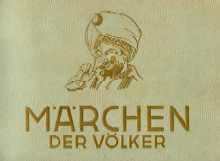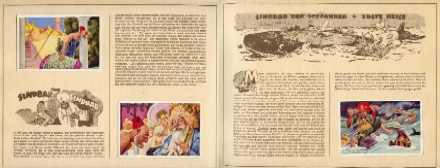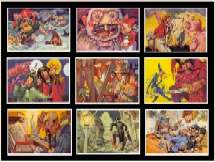


TITLE PAGE
ENGLISH 






I N T R O D U C T I O N :
Who was Stefan Mart?
The mystery of the
teller and illustrator of
Tales of the Nations.
The Project Stefan Mart
P R E V I E W :
All 150 colour pictures
in thumbnail-galleries,
one for each of the 22 stories- The Spirit Lakalak
- Sindbad the Sailor
- Dilldapp the Dunce
- The Beggar's Dream
- The Light in the Night
- Bobby Box
- The Three Divine Brothers
- The Chinese Nightingale
- Master Flea
- Inka h-Ama, Monkey Head
- Thread Devil
- Don Quixote
- King Midas' Donkey's Ears
- The Magic Crocodile
- The Goloshes of Fortune
- Abracadabra
- M'sieur Bonbon
- Knight Bibo and the Devil
- Captain Flint
- Hop-Frog
- That's Success!
- Nirvana
S T O R Y B O O K :
Table of Contents.
All the stories,
pen-and-ink drawings
and colour pictures of
Tales of the Nations
in context. HTML-version
of the 1933 original
G A L L E R Y :
Frameset with three
windows for table of
contents, pictures and
commentaries. All 150
colour pictures of the
story book
C O M M E N T A R I E S :
Analyses of the
9 sample pictures
displayed on the
Entry Page- Sindbad the Sailor
- Dilldapp the Dunce
- Bobby Box
- The Chinese Nightingale
- Master Flea
- Thread Devil
- Don Quixote
- Goloshes of Fortune
- Captain Flint
S I T E M A P
C O P Y R I G H T
C R E D I T S
L I N K S
G U E S T B O O K
C O N T A C T
STEFAN MART - HOMAGE TO AN UNKNOWN ARTIST
Stefan Mart was the narrator and illustrator of the picture book Tales of the Nations, published in Hamburg in 1933 by the "Cigarettenbilderdienst Hamburg-Bahrenfeld" ("Cigarette Picture Service"). It won the hearts of innumerable children and grown-ups in the course of the six years that it was in print. This was due above all to the 150 colour illustrations: they were small in size, but strong in expression, each a microcosm packed with action, each a feast for the eyes like a beautifully set jewel; everything was finely-drawn and clear, indeed with the exaggerated clarity of the caricature; they all radiated the shining, flaming colourfulness of modern painting. These pictures stimulated the imagination and the emotions, moved to laughter and to tears, could frighten and warn. But above all, they gave rise to astonishment - and they have continued to do so to this day.
Tales of the Nations was not an ordinary book that you could buy in a book store: it was a series of four-colour prints, somewhat larger than playing cards, which you received from the Hamburg publisher if you sent them vouchers. The vouchers were sold with Reemtsma cigarette packets. If you wanted the story which the pictures illustrated, you had to buy the collector's album at the tobacconist's: that contained the text of the stories and many additional black and white illustrations. The pictures and the albums are today collectors' items, though not rarities, as hundreds of thousands were printed and distributed all over Germany. Many of the older generation remember the storybook: the pictures have left a deep impression on them. "Ah yes!" white-haired ladies or gentlemen will often exclaim if you show it to them: "Indeed I know it - it's Sindbad the Sailor! But what was the name of that book?"
People seldom remember the title Tales of the Nations and very rarely can anybody come up with the name Stefan Mart. But art dealers and art historians search in vain in their reference books for mentions of the name; there is no trace of it in encyclopaedias or manuals, nor in the catalogues of libraries or museums. One occasionally comes across the name in the internet, mainly in the book lists of second-hand book shops. But not even antiquarians or collectors know who Stefan Mart was, when he was born, who his parents were, where he received his training, lived and worked.
Such a state of affairs perhaps illustrates the status of this artist: his pictures and stories have remained firmly rooted and live on in the memories of so many, whereas he himself has disappeared into the darkness. - It is possible that artists who have achieved success in their lifetimes might envy him for that type of recognition. - However, it is not a very satisfactory state of affairs for the art historian. This artist of outstanding talent did not live in a distant age but at the beginning of the 20th century , a period of great changes in art and of passionate public debate about the nature of modern graphics and painting. How was it possible that the art critics completely overlooked a work containing so many elements of modern painting? This question will be discussed in the Introduction. One reason may have been the fact that the book was published as a free gift to promote a cigarette manufacturer; but the political circumstances will probably have been decisive. Because in 1933, the year in which Tales of the Nations was published, a dictatorship was established in Germany which persecuted everything that seemed to respect other cultures. In 1939 the Hamburg Cigarette Picture Service discontinued the book, replacing it by German Fairy Tales. This book also contained fine pictures, the quality of which matched that of Tales of the Nations. But Stefan Mart's modernistic style was a thorn in the side of the new rulers, and even more so his cosmopolitanism during a period of hectic preparation for war when all efforts to promote international understanding were suppressed. Once the dictatorship had ended and the war was over, the book reappeared for a short time. Remaining copies of the pictures and the albums were sold up to 1947, though it is not clear how this happened, as the offices of the Hamburg Picture Service had been completely destroyed during the bombing of the city. With the buildings, all the documents were burnt which contained information about the author.
So who was Stefan Mart? For the moment all we can say is that he is the master who created Tales of the Nations. We do not know whether he wrote and illustrated other books under this name, or created other works, nor can we exclude the possibility that the tales and pictures are the work of two people. But we do know that the illustrator of the tales was an outstanding graphic artist and painter who struck out on a path all of his own making. He obviously had first-rate training, but he made such original use of everything which can be learnt during a course of studies in art that one has the impression he learnt his craft effortlessly. The caricature is the centre of his talent: the representation of facial expressions and gestures. He is an actor with brush and crayon. His style is versatile: he is a parodist; he is familiar with the world of European painting and with the various genres - landscape painting, still lifes, anatomical painting, costumes, architecture, seascapes and above all animal studies. He is aware of the value of his knowledge and skills: he neither allows himself to be carried away by modernism, nor does he remain fettered by tradition. He achieves the remarkable feat of directing these two very divergent forces as it were into one river bed. The garish, loud, abstract and crazy elements of modern art have their place in this pictorial language; at the same time it remains true to the principles of naturalism: represents and imitates expressions and gestures of man and beast with profound empathy. The result transcends the limits of the book as medium and that of the static image. The artist is fully aware of this and is striving towards new horizons: towards the motion picture, the cinema, in particular the animated cartoon: Stefan Mart is a pioneer of the modern cartoon.
It is to be hoped that the oblivion into which he has fallen is temporary, merely a phase on the road towards recognition - there are many such examples in the history of art. These pages may help to revive his memory. They re-create his book of tales in electronic form, as homage to a forgotten artist. Who knows - perhaps one day the mystery of the creator of Tales of the Nation may be resolved, he will gain recognition as a master of his art and light will dissipate the darkness which has obliterated the traces of his life.
December 2004 - Rainer Würgau


